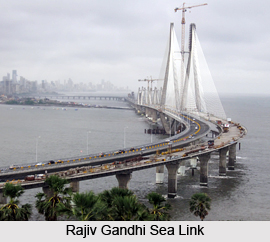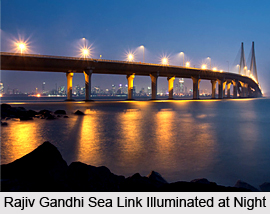 Rajiv Gandhi Sea Link, also known as Bandra-Worli Sea Link, is a cable-stayed bridge having pre-stressed concrete-steel viaducts on either side which links Bandra, situated in western suburbs of Mumbai and Worli, located in south Mumbai, Maharashtra. On 30th June 2009, the first four of the eight lanes of the sea link were opened to the public and on 24th March 2010, all the eight lanes were made open to public. Rajiv Gandhi Sea Link reduced the time of travel between Bandra and Worli from 60 to 90 minutes to 20 to 30 minutes during peak hours. It mainly connects intersection of the Western Express Highway and Swami Vivekananda Road in Bandra to the Khan Abdul Ghaffar Khan Road in Worli. It also connects Mumbai`s arterial Annie Besant Road from Worli Seaface.
Rajiv Gandhi Sea Link, also known as Bandra-Worli Sea Link, is a cable-stayed bridge having pre-stressed concrete-steel viaducts on either side which links Bandra, situated in western suburbs of Mumbai and Worli, located in south Mumbai, Maharashtra. On 30th June 2009, the first four of the eight lanes of the sea link were opened to the public and on 24th March 2010, all the eight lanes were made open to public. Rajiv Gandhi Sea Link reduced the time of travel between Bandra and Worli from 60 to 90 minutes to 20 to 30 minutes during peak hours. It mainly connects intersection of the Western Express Highway and Swami Vivekananda Road in Bandra to the Khan Abdul Ghaffar Khan Road in Worli. It also connects Mumbai`s arterial Annie Besant Road from Worli Seaface.
History of Rajiv Gandhi Sea Link
Previously Mahim Causeway served as the only road linking the western suburbs to Mumbai`s central business district. However during the peak hours it used to become very congested. For easing the congestion the Western Freeway project was proposed spanning over the entire western coastline of Mumbai and Rajiv Gandhi Sea Link, over the Mahim Bay, became the first phase of this freeway system. It offered an alternative route to Mahim Causeway. Commissioned by the Maharashtra State Road Development Corporation, the bridge has been constructed by the Hindustan Construction Company and the project management was led by the UK offices of Dar Al-Handasah.
 Significant technology transfer was also made from China. The foundation stone of the bridge was laid by Bal Thackeray in 1999. The sea link was named after the late Prime Minister of India Rajiv Gandhi.
Significant technology transfer was also made from China. The foundation stone of the bridge was laid by Bal Thackeray in 1999. The sea link was named after the late Prime Minister of India Rajiv Gandhi.
Geology of Rajiv Gandhi Sea Link
Before the designing of Rajiv Gandhi Sea Link the seabed of the route was surveyed. The marine geology underneath the bridge comprises volcanic tuffs, basalts breccias with some intertrappean deposits. Residual soil and weathered rocks covers them. These rocks ranges from being extremely strong to extremely weak and their conditions differ from fresh, massive and intact to highly weathered and fractured. The bed of weathered rocks has been further overlain by calcareous sandstone, transported soil and a thin bed of coarse grained conglomerate. Marine soil layer covers the top of these strata up to a thickness of 9 metres and constitute dark brown basaltic boulders, brown clay silt and fine sand embedded in the silt.
Architecture of Rajiv Gandhi Sea Link
Rajiv Gandhi Sea Link owns the distinction of being the first cable-stayed bridge in open seas in India. The pylons of the bridge have complex geometry owing to the underlying geology. The span of the sea link over the Bandra channel has been identified as one of the longest spans of concrete deck attempted. The major architectural challenges of the bridge included the balancing of engineering complexities with the aesthetics. The superstructures of the viaducts are also known to be the heaviest pre-cast segments constructed in India. A span by span method was used in the building operations. It is also the first infrastructure project in Mumbai which used seismic arresters which enables the sea link to withstand earthquakes measuring up to 8.0 on the Richter scale.



















